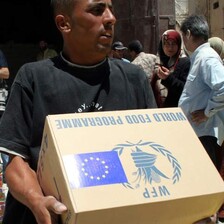The Electronic Intifada Jerusalem 3 August 2012

Most aid organizations remain focused on temporary, short-term solutions rather than the underlying problems of food insecurity.
IRINJERUSALEM (IRIN) - At a glance, the latest data on food security in the West Bank and Gaza Strip — released by the Food and Agriculture Organization, the World Food Programme and the UN agency for Palestinian refugees (UNRWA) in July — seems to warrant optimism.
The year 2011 was the second straight year in which the number of those living in food insecurity declined in the West Bank and Gaza. In the Gaza Strip, the percentage dropped from 60 in 2009 to 44 in 2011; in the West Bank, food insecurity rates have decreased 5 percent in the same two-year period to 17 percent.
But, as UNRWA itself admits, a deeper look into the numbers is less encouraging.
In the West Bank, Palestinians who live in refugee camps have actually experienced a rise in food insecurity — from 25 percent in 2009 to 29 percent in 2011. One quarter of Palestinian households in Israeli-controlled Area C are food insecure — 8 percent more than the West Bank average. Herders’ families in Area C (which covers more than 60 percent of the West Bank) are in a precarious situation, with 34 percent suffering from food insecurity.
And while food insecurity stands at just under 30 percent in the West Bank and the Gaza Strip combined, the World Health Organization reported in May 2012 that 50 percent of infants and children under two in the West Bank and Gaza have iron deficiency anemia. According to the same WHO report, malnutrition and stunting in children under five “is not improving” and could actually be “deteriorating” (“Health conditions in the occupied Palestinian territory” [PDF]).
Dramatic changes
The second intifada saw dramatic changes in Palestinians’ eating habits. Israeli-imposed movement restrictions on both people and goods strangled the economy; Palestinians’ inability to access farmland due to Israeli prohibitions and the construction of Israel’s wall in the West Bank led to reduced agricultural output. Under these pressures, Palestinians increasingly came to rely on cereals, pulses, potatoes, vegetable oil and sugar rather than more costly and more nutritious foods like protein-rich fish and meat, fresh fruits and vegetables.
In 2003, at the height of the second intifada, the Food and Agriculture Organization reported that meals in the West Bank and Gaza Strip often consisted of just tea and bread. Despite these dire circumstances, the FAO did not recommend increased food aid. Instead, the organization stated that the most pressing issue, economic access — or the ability to buy food — must be addressed. In the short term, that meant job creation; in the long term, it meant investment in agriculture.
Yet, almost a decade later, critics say that most aid organizations remain focused on temporary, short-term solutions rather than the underlying problems.
Decline in agriculture
Haneen Ghazawneh, a researcher at the Palestinian Economic Policy Research Institute (MAS) in Ramallah, said international aid was still “going [more] to emergency assistance and food aid and less to development projects,” contributing to “the decline in agriculture.”
Ghazawneh also takes issue with the latest food security data.
“When we talk about economic access [to food] that means having permanent jobs,” she explained. “My worry about these recent reports is that they exclude East Jerusalem, [where] people have very limited [work opportunities].”
She also said the apparent gains in parts of the West Bank, where the Palestinian Authority is nominally in control of many affairs, may be illusory.
In the West Bank, many of those who are food secure are on the PA payroll, said Ghazawneh. But much of the PA’s funding comes from foreign aid, leaving employees vulnerable to changes in the political climate and the global economy — as was the case in July, when the PA could pay only half of employees’ salaries.
“We’re talking about the workers who are the most secure, who have permanent jobs, and they are uncertain,” she said. “The situation is not sustainable at all.”
As many Palestinians have increasingly embraced a culture of consumption and debt, some have bought houses and cars they cannot afford. If salaries suddenly stop coming and people fall behind on their loan payments, the banks could have problems. And this, perhaps, could fuel a larger financial crisis that would have an impact on food security.
This item comes to you via IRIN, a UN humanitarian news and information service, but may not necessarily reflect the views of the United Nations or its agencies. All IRIN material may be reposted or reprinted free-of-charge; refer to the copyright page for conditions of use. IRIN is a project of the UN Office for the Coordination of Humanitarian Affairs.

